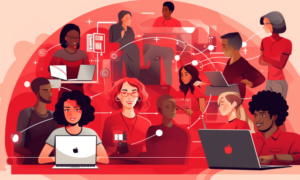Digital HR: Harnessing creative leadership in the digital age
- 7 Min Read
Ollie Henderson, Founder at Future Work/Life and Future of Work specialist, suggests that HR leaders treat creativity as a value and technology as one method of helping make it a reality.
- Author: Ollie Henderson
- Date published: Feb 9, 2023
- Categories

“I’m not very creative.”
After a childhood punctuated by various failures at learning to play instruments and scarred by an inability to progress beyond rudimentary stick people in art class at school, I didn’t consider myself creative. It wasn’t until much later that I understood that creativity isn’t something reserved for painting and music or writing poems or short stories. Instead, it manifests in manifold ways differently for every individual.
We can all be creative if we follow our curiosity and focus on things we genuinely care about.
And as you’ll have heard by now, while creativity has always been an important skill at work, it’s about to become the most significant of all.
As technology and automation change the nature of jobs over the coming decades, the defining contribution of humans to business and society will be characteristics like creativity, context and critical thinking.
As London Business School professor Lynda Gratton explained to me on my podcast, Future Work/Life:
“Humans do two things that machines don’t. They show high levels of empathy, and they listen. When you speak to a machine, it doesn’t understand you. It’s not empathising with you. The second thing that humans can do is be creative, bring in new ideas, and make new connections.”
For the time being at least, it seems unlikely that machines will be able to replicate our ability to make links between previously unconnected ideas.
Of course, creativity can mean many different things, but consider these three perspectives for inspiration.
- Tim Oldman, CEO of workplace experience specialist Leesman, highlights the need to think afresh about the skills required in future workplaces, starting with leadership. Not least, “applying historical skills to a whole new set of challenges and dialling up the creativity, to ensure ‘no’ is not the first answer” to the difficult questions asked by people taking a more flexible approach to their work.
- Melissa Daimler, who’s spent her career leading learning and development at companies like Adobe, Twitter and WeWork, is now Chief Learning Officer at online course business, Udemy. She explained to me how teams work creatively to develop a set of shared values, which ultimately help shape an organisation’s culture. With the location and mode of work changing, this becomes even more important as relationships adapt and evolve.
- In her former role as Director of Operations of Uber, venture capitalist Cleo Sham told me how they used viral video games to boost brand recognition and drive new registrations. Creativity is now one of the key attributes she looks for in founders, but it’s not just about sales and marketing, although that helps. Entrepreneurs need to show how they think differently about solving problems by approaching them from new angles. As Cleo puts it: “their ability to see around corners.”
The age of technology
So if, in the future of work, you need to up your creative game as a leader, how can you prepare yourself and your team?
The short answer is to remain focused on how you can positively influence human behaviour by embracing complementary technology.
It’s easy to get carried away with how exciting technological advances will change our lives. When it comes to our work, the temptation is to picture every role being revolutionised by machine learning and automation – some of which will happen, but much of it won’t. But creativity isn’t something you just switch on when getting together on those in-office days, arranging the virtual whiteboard sessions, or even cultivating ‘watercooler moments’ (virtual or otherwise).
Instead, treat creativity as a value and technology as one method of helping make it a reality.
How?
In the case of the recent interest in generative AI, the clue to its utility is in the name. As a tool. Another resource to help generate ideas. And in this way, it could be incredibly powerful. Think of it as a muse to the individual artists in your team, proposing new and varied possibilities that can help them see around corners and consider eventualities that aren’t immediately obvious, like an incredibly well-read researcher who can add both range and depth to the process of analysis and consideration.
For now, that’s where the value of the technology ends because when it comes to decision-making, the appreciation of context and the ability to look through an empathetic lens makes human judgement unique.
Having run an advertising agency for a decade in which we introduced programmatic technology and algorithms to optimise media planning and buying, you might assume that I attribute less value to the roles of humans nowadays. But the opposite is true. An appreciation of human perception and counterfactual thinking became more evident. Yes, there were efficiencies to be had through employing technology to speed up the buying process and identify trends, but the algorithm wasn’t the determinant factor in a campaign’s success. After all, in most industries, the technology quickly becomes commoditised and standardised.
No, the secret to harnessing the power of technology was finding the right people to use it! Specifically, building a team with the right combination of experience, knowledge, personality, and unique perspectives.
Embracing diverse thinking
All of which highlights the last of those human qualities I referenced above – critical thinking.
At its best, critical thinking arises from teams with diverse viewpoints and in which logic isn’t applied indiscriminately to the detriment of emotion, passion and conviction. Embrace differences of opinion because divergent thinking is a significant contributor towards innovation and creating category-defining companies.
Which is another critical way we remain distinct from machines – they can not contribute a point of view. And as legendary computer scientist, Alan Kay once said:
“A point of view is worth 80 IQ points.”
So, how can you develop a creative human-centric culture, which takes advantage of emerging technology?
Apply the lessons of the Work/Life Flywheel.
- Mindset: Whether your organisation builds or deploys advanced technology, the key factor in your success remains the humans using it – leverage your people’s inherent curiosity while always communicating the importance of curiosity as value.
- Creativity: Like any muse, technology can provide inspiration and offer new information, but the decisions about how to apply the creative insights should flow through your people – in this world, technology and automation should make their job more human.
- Experimentation: Many of the most exciting breakthroughs in business and art come accidentally, through constant testing and learning, so apply the 80/20 rule (20% focused on trying new things and 80% doubling down on what works) – plus, don’t forget to celebrate the experimentation, whether it works or not!
- Community: Some of the greatest business innovations in recent memory have come from the removal of geographic and communication barriers, creating new opportunities to build diverse, engaging and collaborative cultures – prioritising using technology to enhance relationship-building rather than creating a barrier to it.
- Learning: Since personal growth remains top of most people’s priorities, the most obvious way of retaining and developing talent is by building a system to share knowledge and improve skills – design and experiment with peer-to-peer coaching as well as formal learning platforms.
- Breakthroughs: Legendary leadership requires great communication, clear direction and cultivating purpose, but it also involves celebrating progress – encourage people to schedule downtime and to consistently share their personal and team highlights.
Creativity is a state of mind and a willingness to think differently about problems and solutions.
Your role as a leader is ensuring that technology enables people to fulfil their potential by being more human!









